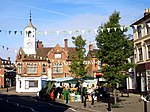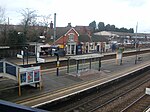Ampthill Rural District
Ampthill was a rural district in Bedfordshire, England from 1894 to 1974. It entirely surrounded but did not include the urban district of Ampthill. The district had its origins in the Ampthill Rural Sanitary District. This had been created under the Public Health Acts of 1872 and 1875, giving public health and local government responsibilities for rural areas to the existing Boards of Guardians of Poor Law Unions.Under the Local Government Act 1894, Rural Sanitary Districts became Rural Districts from 28 December 1894. The link with the Poor Law Union continued, with all the elected councillors of the Rural District Council being ex officio members of the Ampthill Board of Guardians. The first meeting of the new council was held on 3 January 1895 in the board room of the Ampthill Union Workhouse. The council's first chairman, Edward Crouch, had been the chairman of the previous Board of Guardians.In 1900 the district was significantly enlarged, when the neighbouring Woburn Rural District was abolished, with the majority of the former Woburn district becoming part of the Ampthill Rural District. The council was granted a coat of arms in 1957.The rural district contained the following civil parishes. All the parishes added to the district in 1900 were from the abolished Woburn Rural District:
Excerpt from the Wikipedia article Ampthill Rural District (License: CC BY-SA 3.0, Authors).Ampthill Rural District
Oliver Street,
Geographical coordinates (GPS) Address Nearby Places Show on map
Geographical coordinates (GPS)
| Latitude | Longitude |
|---|---|
| N 52.027 ° | E -0.495 ° |
Address
Oliver Street
Oliver Street
MK45 2NJ
England, United Kingdom
Open on Google Maps








